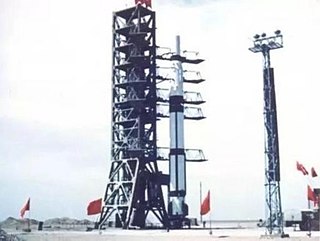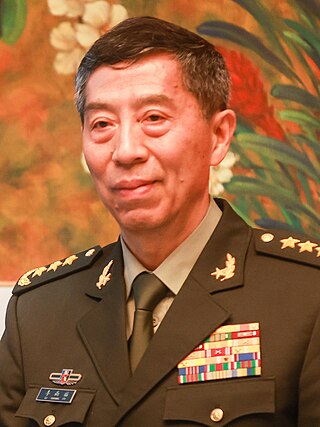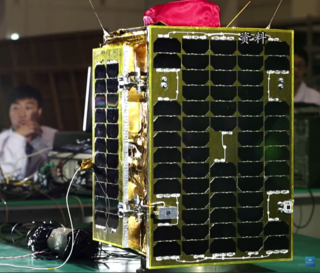
Jiuquan Satellite Launch Center is a Chinese space vehicle launch facility (spaceport) located between the Ejin, Alxa, Inner Mongolia and Hangtian Town, Jinta County, Jiuquan, Gansu Province. It is part of the Dongfeng Aerospace City. Because 95% of JSLC located in Jinta County, Jiuquan, the launch center is named after Jiuquan. The launch center straddles both sides of the Ruo Shui river.

The space program of the People's Republic of China is about the activities in outer space conducted and directed by the People's Republic of China. The roots of the Chinese space program trace back to the 1950s, when, with the help of the newly allied Soviet Union, China began development of its first ballistic missile and rocket programs in response to the perceived American threats. Driven by the successes of Soviet Sputnik 1 and American Explorer 1 satellite launches in 1957 and 1958 respectively, China would launch its first satellite, Dong Fang Hong 1 in April 1970 aboard a Long March 1 rocket, making it the fifth nation to place a satellite in orbit.

The China Aerospace Science and Technology Corporation (CASC) is a main contractor for the Chinese space program. It is state-owned and has subsidiaries which design, develop and manufacture a range of spacecraft, launch vehicles, and ground equipment. It also has a division for strategic and tactical missile systems.

The Taiyuan Satellite Launch Center (TSLC) also known as Base 25 (Chinese: 二十五基地), is a People's Republic of China space and defense launch facility (spaceport). It is situated in Kelan County, Xinzhou, Shanxi Province and is the second of four launch sites having been founded in March 1966 and coming into full operation in 1968.

The People's Liberation Army Rocket Force, formerly the Second Artillery Corps, is the strategic and tactical missile force of the People's Republic of China. The PLARF is the 4th branch of the People's Liberation Army (PLA) and controls China's arsenal of land-based ballistic, hypersonic, cruise missiles—both nuclear and conventional. The armed service branch was established on 1 July 1966 and made its first public appearance on 1 October 1984. The headquarters for operations is located at Qinghe, Beijing. The PLARF is under the direct command of the Chinese Communist Party's Central Military Commission (CMC).

The Wenchang Space Launch Site is a rocket launch site located in Wenchang on the island of Hainan, in China.

Beijing Aerospace Flight Control Center, formerly known as Beijing Aerospace Command and Control Center, is a command center for the Chinese space program which includes the Shenzhou missions, and is located in a suburb northwest of Beijing under the administration of Haidian District. The space center main entrance is located at the intersection of Beiqing Road and You Yi Road as shown by the photograph.
The People's Republic of China carried out a land-based high-altitude anti-ballistic missile test on 11 January 2010. This reportedly made China the second country in the world after the United States of America to successfully destroy an incoming missile beyond the Earth's atmosphere.
Kuaizhou is a family of Chinese "quick-reaction" orbital launch vehicles. Flying since 2013, Kuaizhou 1 and 1A consist of three solid-fueled rocket stages, with a liquid-fueled fourth stage as part of the satellite system. Kuaizhou 11, which flew an unsuccessful maiden flight in July 2020, is a larger model able to launch a 1,500 kg (3,300 lb) payload into low Earth orbit. Heavy-lift models KZ-21 and KZ-31 are in development. The Kuaizhou series of rockets is manufactured by ExPace, a subsidiary of China Aerospace Science and Industry Corporation (CASIC), as their commercial launch vehicles.
The Xi'an Satellite Tracking, Telemetry, and Control Center, also known as Base 26, is the primary satellite telemetry, tracking, and control facility of the People's Republic of China. Located in the Beilin District of Xi'an, Shaanxi Province, XSCC is subordinate to the Satellite Launch, Tracking, and Control Department of the People's Liberation Army Strategic Support Force (PLASSF).

The People's Liberation Army Strategic Support Force was a service branch of the People's Liberation Army that existed from December 2015 to April 2024.

The Equipment Development Department of the Central Military Commission is a major unit of deputy theater grade under the Central Military Commission of the People's Republic of China. It was founded on January 11, 2016, under Xi Jinping's military reforms. The department mission is to coordinate, oversee, and foster the development and acquisition of military technology. Gen. Zhang Youxia served as the first director. The current director is Xu Xueqiang. It also registers the patents related to military technology. The Manned Flight Office is also hosted there, meaning that the Department plays a critical role in the Chinese space program.

Ren Xinmin was a Chinese aerospace engineer and a specialist in astronautics and liquid rocket engine technology. He was the technical director of the Long March 1 rocket, which launched the Dong Fang Hong I, China's first satellite, and the chief designer of Chinese storable propellant rocket engine. He was also the chief designer for the Long March 3 launch vehicle, Fengyun, and SJ (Shijian) series satellites.

Li Shangfu is a Chinese aerospace engineer and former military administrator who served as the 13th Minister of National Defense of China and as State Councillor of China from March to October 2023. He joined the People's Liberation Army (PLA) as a technician at the Xichang Satellite Launch Center in 1982. He was conferred the rank of general in July 2019 and was appointed as a member of the Central Military Commission in October 2022. In August 2023 Li disappeared from public view and was then removed from office on October 24, 2023. He is both the shortest-serving Minister of National Defense and the first from the PLA Strategic Support Force.

Jilin-1 is China's first self-developed commercial remote sensing satellite system. The satellites are operated by Chang Guang Satellite Technology Corporation and named after Jilin Province where the company is headquartered. The first set of satellites were launched by Long March 2D in Jiuquan Satellite Launch Center on 7 October 2015, at 04:13 UTC. All launched Jilin-1 satellites are in Sun-synchronous orbit (SSO).
Tiantong is China's first mobile communications satellite system. The first satellite Tiantong-1-01 was launched on August 6, 2016 (UTC+8).

The Luoyang Electronic Equipment Test Center (洛阳电子装备试验中心), also known as the 33rd Test and Training Base of the People's Liberation Army (中国人民解放军第三十三试验训练基地) is a research and development center of the People's Liberation Army located in Luoyang, Henan) Province and is affiliated to the PLA's Aerospace Force. It is a Division Grade unit that mainly performs scientific research and defense technology development, including during the last few decades, projects related to the Chinese space program.

The China Maritime Satellite Tracking and Control Department ), MUCD 63680, is a deputy-corps grade naval base located at Jiangyin City in Jiangsu Province, established in 1978 as the headquarter and home port for the Yuan Wang-class tracking ships, which are used to track rocket and missile launches, in particular the testing of the Dongfeng series ballistic missiles and Long March rockets. Since 1 January 2016, it has been subordinate to the Main Department of Satellite Launches and Orbit Tracking and Control (卫星发射测控系统部) of the Strategic Support Force, and then from April 2024 of the Aerospace Force.












